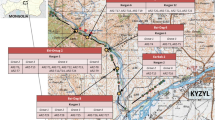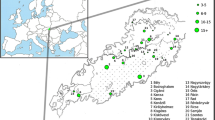Abstract
Isolated populations have been the object of several genetic and anthropological studies, since endogamy and inbreeding often lead to the acquisition of a particular gene pool.
In this context, we studied the small, ancient population of Postua in the north-western Italian Alps. We used biodemographic and molecular techniques to analyse the population structure in order to evaluate the relationship between geographical and genetic isolation.
We examined about 26,000 certificates kept in the town and parish archives, concerning the period from 1640 to 1999. High rates of endogamy and isonymy, short marriage distances and a low ratio between the number of surnames and the number of individuals were inferred.
In the molecular analysis, we compared the distribution of Y chromosome SNPs (single nucleotide polymorphisms) with those of mitochondrial variations and Y chromosomal microsatellites (short tandem repeat polymorphisms) in 102 healthy individuals originating from Postua. A control sample (94 individuals) was collected from a plain area, 50 km away.
We examined 23 SNPs and an Alu repeat, located in the nonrecombinant portion of the Y chromosome. To further delineate Y chromosome lineages, the biallelic haplogroups were further resolved using Y microsatellite markers (DYS19, DYS391, DYS392, DYS393).
Mitochondrial HVS-I and HVS-II regions were sequenced, and RFLP screening with the six classical enzymes was performed.
Postua is similar to other populations living in northern Italy, but it shows a lower number of haplotypes.
The samples were compared with other European populations. We calculated genetic distances according to Reynold and Nei and we carried out a phylogenetic analysis by phylogenetic trees and reduced median networks construction.
Postua clusters with other samples from northern Italy but in a separate position, probably indicating drift phenomena. These relationships are supported by AMOVA (analysis of molecular variance).
Our results suggest that the influence of neighbouring populations on the gene pool of Postua has been very low through both females and males.
Similar content being viewed by others
References
Boetsch G., Prost M., Rabino-Massa E. (2002) Evolution of consanguinity in a French Alpine valley: the Vallouise in the Briançon region (17th–19th centuries). Hum. Biol., 74 (2): 285–300.
Crow J. F., Mange A. P. (1965) Measurement of inbreeding from the frequency of marriages between persons of the same surname. Eugenics Quarterly, 12: 4.
Fisher R. A. (1943) The relation between the number of species and the number of individuals in a random sample of animal population. Jour. Anim. Ecol., 12: 4.
Lasker G. W.et al. (1972) Degree of human genetic isolation measured by isonymy and marital distances in two communities in an Italian Alpine Valley. Human Biology, 44 (3): 351–360.
Richards M. B.et al. (1998) Phylogeography of mitochondrial DNA in western Europe.Ann. Hum. Genet., 62: 241–260.
Semino O.et al. (2000) The genetic legacy of PaleolithicHomo sapiens sapiens in extant Europeans: a Y chromosome perspective. Science, 290: 1155–1159.
Sutter J., Tabah L. (1948) Fréquence répartition des mariages consanguins en France. Population, 4: 607–630.
Torroni A,et al. (1998) MtDNA analysis reveals a major late Palaeolithic population expansion from southwestern to northeastern Europe. Am. J. Hum. Genet., 62: 1137–1152.
Author information
Authors and Affiliations
Rights and permissions
About this article
Cite this article
Marin, A., Achilli, A., Di Gaetano, C. et al. Biodemographic and molecular analysis of an isolated Alpine population (Postua). Int. J. Anthropol. 20, 259–275 (2005). https://doi.org/10.1007/BF02443062
Issue Date:
DOI: https://doi.org/10.1007/BF02443062




